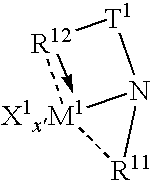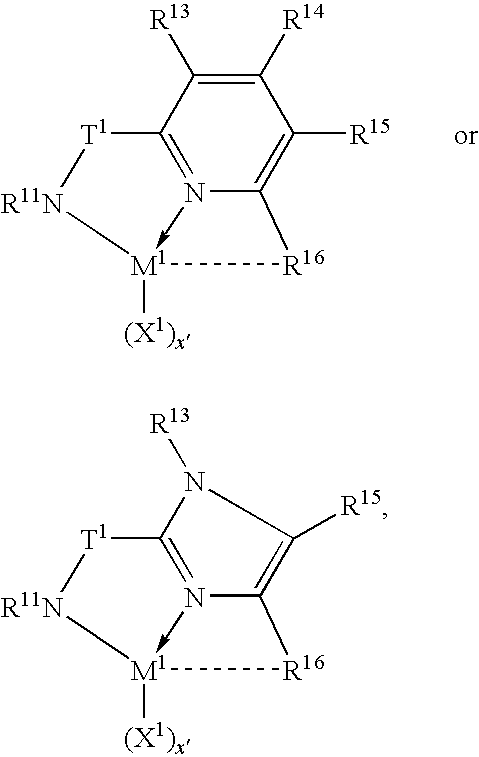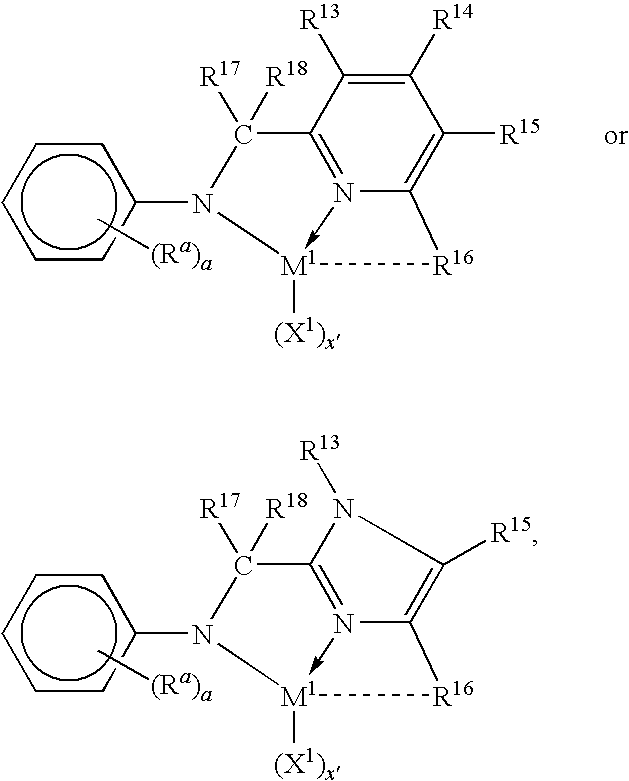Tethered supported transition metal complex
a transition metal complex and metal complex technology, applied in the field of supported transition metal complexes, can solve the problems of low productivity of catalyst compositions, inability to chemically attach any of the catalyst components, and unsuitable for use in slurry polymerization, so as to improve performance, yield and efficiency. high, the effect of being ready to prepar
- Summary
- Abstract
- Description
- Claims
- Application Information
AI Technical Summary
Benefits of technology
Problems solved by technology
Method used
Image
Examples
specific embodiments
[0120]The following specific embodiments of the invention and combinations thereof are especially desirable and hereby delineated in order to provide detailed disclosure for the appended claims.[0121]1. A supported metal complex comprising the reaction product of:[0122](A) a transition metal complex of a polyvalent heteroaryl donor ligand containing at least one ortho-metallated aromatic ligand group, and[0123](B) an ethylenically or poly(ethylenically) functionalized particulated organic or inorganic solid.[0124]2. A supported metal complex according to embodiment 1 wherein the particulated solid is silica modified by reaction with a trialkylaluminum compound and further functionalized by reaction with an ethylenically unsaturated compound containing protonated Lewis base functionality.[0125]3. A supported metal complex according to embodiment 2 wherein the ethylenically unsaturated compound containing protonated Lewis base functionality is a hydroxyl, thiol, amine or phosphine fun...
example 1
ω-Undecenyloxy(ethyl)aluminum modified silica (CH2═CH2—(C9H18)—O—Al(C2H5)—O—Silica) (vinyl functionalize support according to the present invention)
[0143]In an inert atmosphere glove box, 4.00 g of support A is added to a 100 ml glass flask and slurried in 20 ml of toluene. To the agitating slurry is added, dropwise, 0.16 mL (200 μmol) of ω-undecenyl alcohol. The mixture is agitated on a mechanical shaker for 2 hours. The resulting solids are collected on a fritted funnel, washed twice with 20 mL toluene, and dried under reduced pressure for 16 hours.
Catalyst A* (Comparative)
[0144]In an inert atmosphere glove box, 1.00 g of support A is added to a 20 ml glass flask and slurried in 5 ml of toluene. To the agitating slurry is added, dropwise, 7.5 mL of a 0.04 M solution of tris(pentafluorophenyl)boron in toluene. Next, 2.5 mL of a 0.04 M solution of [N-[2,6-bis(1-methylethyl)phenyl]-α-[2-(1-methylethyl)phenyl]-6-(1,2-naphthalendiyl-κ-C2)-2-pyridinemethanaminato (2-)-κN1,κN2]hafnium di...
example 2
Supported Catalyst According to the Invention
[0145]In an inert atmosphere glove box, 1.00 g of support B (Example 1) is added to a 20 ml glass flask and slurried in 5 ml of toluene. To the agitating slurry is added, dropwise, 7.5 mL of a 0.04 M solution of tris(pentafluorophenyl)boron in toluene. Next, 2.5 mL of a 0.04 M solution of [N-[2,6-bis(1-methylethyl)phenyl]-α-[2-(1-methylethyl)phenyl]-6-(1,2-naphthalendiyl-κ-C2)-2-pyridinemethanaminato (2-)-κN1,κN2]hafnium dimethyl is diluted with 5 mL additional toluene and added to the slurry. The mixture is agitated on a mechanical shaker for 2 hours. The resulting solids are collected on a fritted funnel, washed twice with 10 mL toluene, and dried under reduced pressure for 16 hours.
[0146]The foregoing preparation of a supported tethered, activated, metal complex is illustrated schematically in the following diagram:
Slurry Batch Reactor Polymerization
[0147]A cleaned, nitrogen purged, 2 liter, jacketed and stirred autoclave reactor is ch...
PUM
| Property | Measurement | Unit |
|---|---|---|
| densities | aaaaa | aaaaa |
| densities | aaaaa | aaaaa |
| particle size | aaaaa | aaaaa |
Abstract
Description
Claims
Application Information
 Login to View More
Login to View More - R&D
- Intellectual Property
- Life Sciences
- Materials
- Tech Scout
- Unparalleled Data Quality
- Higher Quality Content
- 60% Fewer Hallucinations
Browse by: Latest US Patents, China's latest patents, Technical Efficacy Thesaurus, Application Domain, Technology Topic, Popular Technical Reports.
© 2025 PatSnap. All rights reserved.Legal|Privacy policy|Modern Slavery Act Transparency Statement|Sitemap|About US| Contact US: help@patsnap.com



